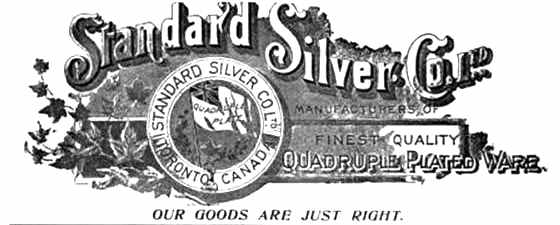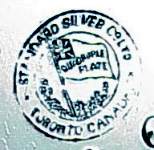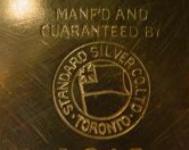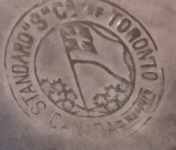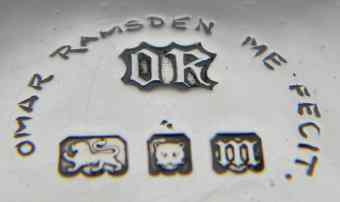YOUR GUIDE TO JANUARY NEWSLETTER:
articles
new members
members' window
mail to ASCAS
replies to questions
a page per month
a silversmith per month
a word per month
a book on my shelf
a crest per month
contributors to this Newsletter
search engine
disclaimer and privacy policy
2017 ASCAS membership
LAST WARNING
Members still interested to ASCAS and its activity are
invited to send an e-mail to:
Confirming your 2017 membership please compile a new mail
and don't use the "reply" button on this mail.
No action is requested to unsubscribe. Members not confirming
their membership will be automatically deleted and shipping of
our monthly Newsletter will be suspended on February
2017.
Giorgio Busetto
ASCAS Secretary
PLEASE IGNORE THIS
ANNOUNCEMENT IF YOU HAVE ALREADY CONFIRMED YOUR INTEREST, BY
EMAIL, WITHIN DECEMBER 2016.
A new article for ASCAS website

David McKinley presents:
An Interesting Early English Spoon

The English seal top spoon was made from the early 16th century well into the 17th. It takes its name from the flat top surmounting a baluster which was cast separately and soldered onto the stem end of the spoon although there is no evidence that armorials were ever engraved on it to act as a seal.
Most of these flat "Seal" tops were round but until the latter part of the 16th century they were hexagonal in shape so that this spoon can be dated to the 16th century since it clearly has a hexagonal top. Further it is likely to be later in the century rather than earlier since earlier spoons had much more fig shaped bowls whereas the bowl on this spoon is almost round. I date it to about 1570.
The spoon was not made in London or it would have the leopard's head struck in the bowl. Although the law required that the leopard's head be struck on all wrought silver only the Goldsmiths' Company of London were assiduous in complying with this law and provincial spoons either have a town mark struck in the bowl or, on early ones, a maker's mark. Another way to tell that a spoon is of provincial make, although it is not clear in this illustration, is by the way in which the cast finial is fixed to the stem end. London made spoons had their finials soldered into a "V" notch cut into the stem end whereas the finials on provincial spoons were soldered on by means of a "lap joint"...
click here

New members
Welcome to new ASCAS members:
Michelle Chessell - Australia
Patricia Godfrey - USA
Pam Stanier - England UK
Mail to ASCAS:
e-mail
silverassociation@yahoo.it
Andrew J. Brasch writes:
... I hope somebody can help to identify the maker.
This is a beautiful small Austrian enamel on silver tazza.
There is a capital R and a very small mark next to it, not visible.
Andrew J. Brasch
Only a hypothesis: could be Hermann Ratzersdorfer, see the article in our website Historismus Silver-Gilt Dessert Set by Hermann Ratzersdorfer a specialist on this type of enamelling.
Giorgio Busetto
Demetrios Leontaris writes:
... I just acquired a metal box. It has a dragon etched onto the top and underneath these little stamps.
Anything you can tell me about it?
Demetrios Leontaris
Céline Cadillac writes:
... My Last acquisition ... PAIR OF BUCKLE OF CAPE ARGENT MASSIF 1819. It dates from between 1819 and 1820
It has several punches:
- One head of Vieillard: 1st title (950/1000 M)
- One Mask: Average warranty, Paris
- Two Crab:
- Goldsmith: an open compass - GD - a branch of holly
- A head of Minerva on the right: punch of average guarantee of Paris between 1809 and 1819. Trials of countermarking having been made to the office of the guarantee of Paris on 1 August 1817, one can find this punch insulated with countermark.
Weight of the 2 pieces: 25 grams (12 + 13)
Total length of the 2 pieces: 14 cm
Height of 1 piece has its largest diameter: 5 cm
I did not succeed in discovering the goldsmith hiding under this punch - an open compass - G D (between 1819 and 1838) if someone can help me? Thanks in advance!
Céline Cadillac
Robert Massart writes
The maker's mark, Robin Holmes is asking for, belongs to the silversmith company Saint Médard, 5 rue Froissart, Paris.
Active since 1898 till present. The symbol of the mark SM is the cane of the Bishop St Médard (crosse de l'Evêque Saint Médard).
Robert Massart
Janjaap Luijt writes
As a response to the question of Sean Flynn, I would say it's Stockholm 1880. Unfortunately I don't have a clue to the maker, because I lack a decent reference.
met vriendelijke groet,
Janjaap Luijt
Rod Hall writes
I can help Sean Flynn to identify and date his inkwell. I note he says they were bought in Sweden 5 years ago and that is indeed where the silver cap is made, not France. The cap was made in 1880 (from the B6 date code) by the firm known as GuldsmedsAktieBolaget, (translates as "Goldsmiths Company Limited") who used the initials GAB as their makers mark. The final stamp is the town mark for Stockholm, showing the head of Saint Erik.
Rod Hall
"A PAGE per MONTH"
In this column we presents a page obtained from makers'
brochures, books, auction catalogs, advertising or whatever
other printed paper, related to silver, that may be of interest
for ASCAS members.
The images will be published at a "low resolution" level and for
private and personal use only.
This column is published under the kind permission of Giorgio
Busetto's website

"A WORD per MONTH"
In this column we
present an abstract from a page of the "What is? Silver Dictionary"
courtesy of


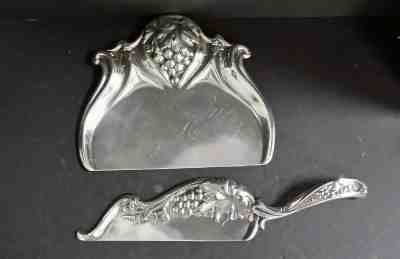
|
CRUMB SCOOP
CRUMB TRAY
The crumb scoop is a dinner table accessory used to remove crumbs from the table during the meal before serving the dessert.
It has a flat horizontal blade and a curved rim on the rear side to retain the crumbs.
The long horizontal handle is made of silver or in other suitable material as bone, ivory, mother-of-pearl, wood or ivorine.
The scoop tray is a small tray having one flat undecorated edge into which the crumbs are swept by means of an accompanying brush or a crumbs scoop.
The blades were often engraved with floral motifs but sterling silver items are rare and most of them are made in silverplate..... MORE...
|
"A SILVERSMITH per MONTH"
|
|
OMAR RAMSDEN - RAMSDEN & CARR
Omar Ramsden (born Sheffield, 21 Aug 1873; died London, 9 Aug 1939).
The son of a silver and electroplate manufacturer, he was apprenticed to a company of silversmiths and attended evening classes at Sheffield School of Art where he met Alwyn Carr (1872-1940) and then both had summer classes at the Royal College of Art of London.
In 1898 Ramsden set up a partnership with Alwyn Carr and opened a studio in Chelsea (London) moving soon after the workshop to Fulham. Later the studio and the workshop were reunited in the same location in Seymour Place (St. Dunstan's building). There they exploited the fashionable taste for handmade silver of the Arts and Crafts Movement and, with the help of skilled artisans, made articles adapted from Gothic and Renaissance designs with Celtic-style inscriptions, which became their trademark....
more
|
"A CREST per MONTH"
BAGSHAWE
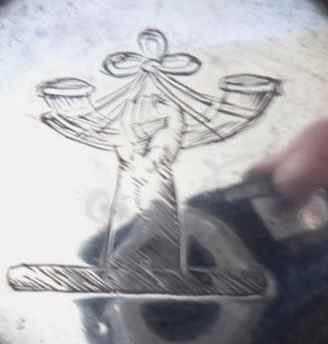
|
The crest of Bagshawe family.
The crest is described as 'an arm erect, in hand a bugle horn'
The crest was found on a silverplate wine bottle coaster, maker William Hutton & Sons, Birmingham
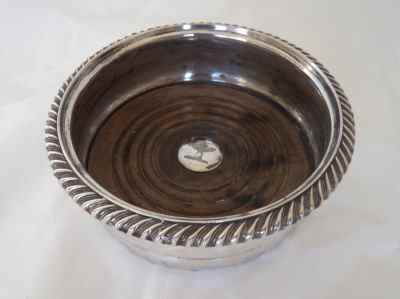

|
Closing our January 2017 edition of ASCAS Newsletter I hope
you have appreciated its content.
Your comments, suggestions and advice will be of great help.
My thanks to Andrew J. Brasch, Céline Cadillac, Demetrios Leontaris, Janjaap Luijt, David McKinley, Robert Massart and Daniel Monk, for their precious contributions.
Giorgio Busetto
Secretary
DISCLAIMER AND PRIVACY POLICY
ASCAS is a community of people having a common
interest in antique silver.
It is a non-profit association without commercial links.
Membership is open to whomever has a true interest in
this subject matter.
ASCAS has no real property and no fees are requested nor
accepted from members.
ASCAS keeps in touch with its members only through
periodical newsletters, e-mails and web-site updating
and ignores and is not responsible for any other
activity pursued by its members.
Likewise, ASCAS is not responsible for opinions,
evaluation and images displayed, and in any form
published or supplied for publication, by its members
who, in any case, maintain the property of their works
and assure the respect of national and international
legislation about Intellectual Property.
ASCAS does not have the full addresses of its members (only
town, country and e-mail address are requested for
membership).
ASCAS handles and protects with care its members' e-mail
addresses, will not disclose the addresses to third
parties, will use this information only to reply to
requests received from members and for communications
strictly related to its activity.
These rules are expressly accepted by submitting the
membership request.
|
|
 newsletter
# 152 January 2017
newsletter
# 152 January 2017